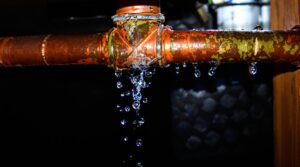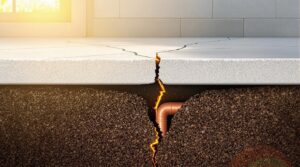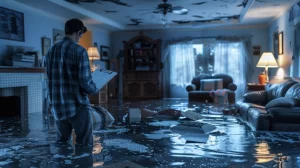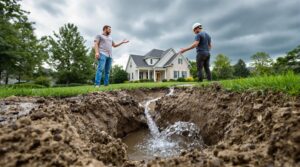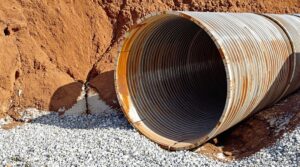Cleaning underground drainage pipes requires proper tools and systematic techniques. Professional-grade drain snakes with corkscrew ends effectively break down organic obstructions, while high-pressure water systems dislodge stubborn debris. Initial inspection using snake cameras identifies blockage locations and types. Essential steps include disconnecting downspouts, deploying mechanical cleaners, and utilizing wet/dry vacuums for material extraction. For severe blockages, professional hydro-jetting services provide thorough solutions. Understanding the full scope of maintenance options guarantees peak drainage system performance.
Key Takeaways
- Disconnect downspout and use a drain snake with corkscrew end to break down and extract accumulated organic debris and minor blockages.
- Deploy a high-pressure water stream using a garden hose or professional hydro-jetting system for stubborn, compacted obstructions.
- Utilize a wet/dry vacuum or leaf blower to remove loose debris and sediment from accessible sections of the pipe.
- Inspect pipe interiors using snake cameras to identify blockage locations and types before selecting appropriate cleaning methods.
- Install gutter guards and perform bi-annual inspections to prevent future blockages and maintain proper drainage system functionality.
Understanding Common Drainage Pipe Blockages
When underground drainage pipes develop blockages, homeowners must understand the common culprits to implement effective cleaning solutions. Organic debris, including leaves, sticks, and soil sediment, frequently accumulates within drainage systems, creating flow restrictions that can lead to serious backups if left unaddressed.
Particularly problematic are compacted materials and adhesive substances like mud, which can form stubborn obstructions resistant to standard drain snake interventions. These blockages often require specialized cleaning approaches to restore proper flow.
Additionally, root intrusion through compromised pipe sections compounds blockage issues, as roots entangle with accumulated organic matter to form dense obstacles.
Regular system inspection and maintenance protocols are essential for identifying potential blockages before they become severe.
Understanding when pipes were last serviced provides valuable insight into the possible extent of accumulation and helps determine appropriate cleaning methods to maintain system functionality and prevent future obstructions.
Essential Tools and Equipment for Pipe Cleaning
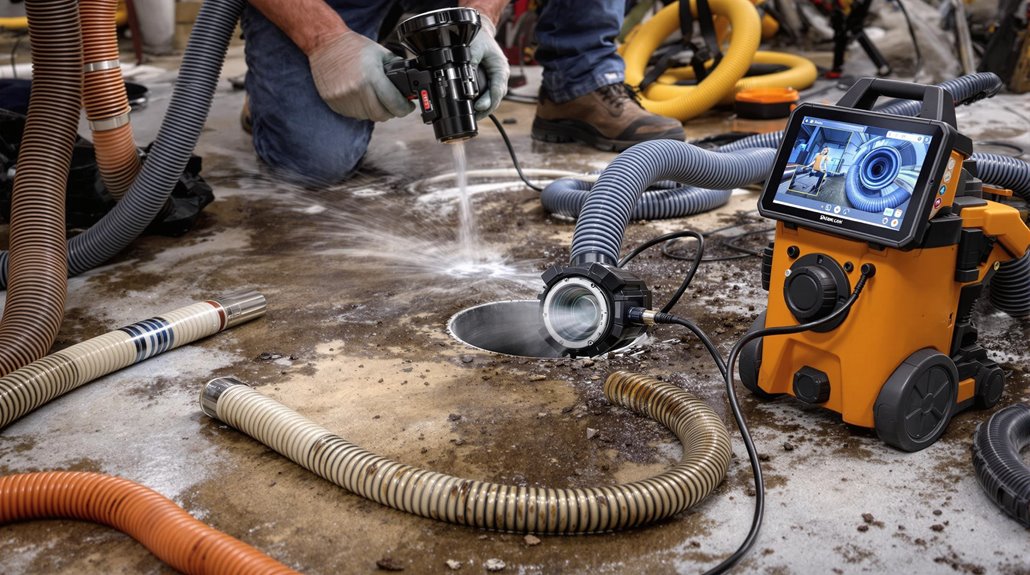
Professional drainage pipe maintenance requires a thorough arsenal of specialized tools and equipment to effectively address various types of blockages.
The cornerstone of any drain pipe cleaning operation is the drain snake, particularly models featuring a corkscrew end, which excels at breaking down and extracting organic obstructions like leaves and twigs.
High-powered hoses with adjustable jet settings serve as essential tools for dislodging stubborn debris, though operators must exercise caution to prevent pipe damage.
For efficient removal of dry materials, wet/dry shop vacuums and leaf blowers provide quick, effective solutions.
Diagnostic capabilities are enhanced through the use of snaking cameras, which enable precise identification of blockage locations and composition.
Commercial jet tips, when properly attached to pressure washers, deliver concentrated force for dismantling persistent clogs.
This combination of tools guarantees thorough maintenance capabilities for underground drainage systems while maintaining structural integrity.
Step-by-Step Cleaning Methods and Techniques
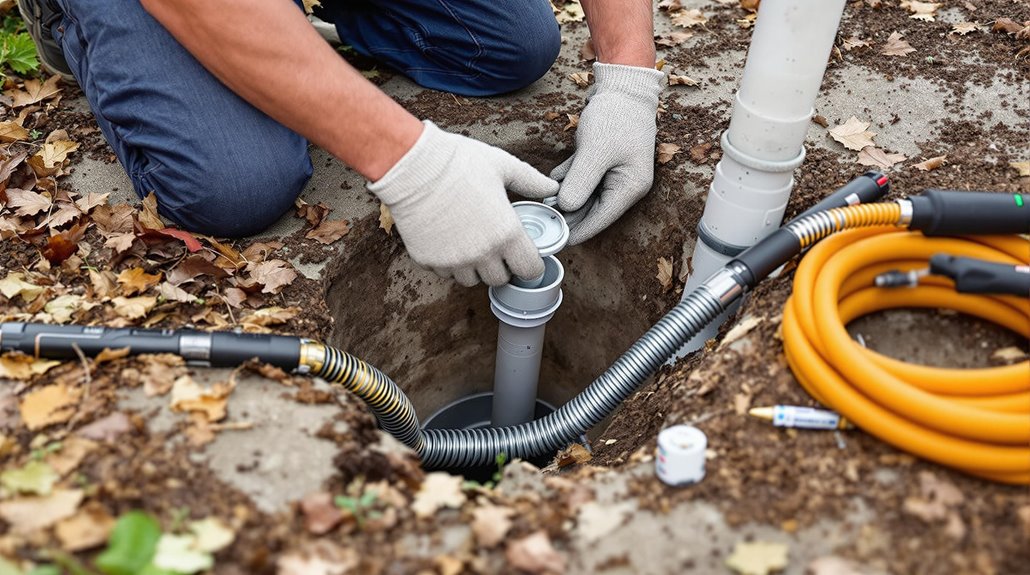
Maintaining underground drainage pipes requires a systematic approach that prioritizes safety and effectiveness. The process begins with disconnecting the downspout from the underground drain to establish clear access for cleaning operations. This initial step facilitates the implementation of various unclog underground techniques.
For minor blockages, a drain snake equipped with a corkscrew end proves effective in dislodging and extracting accumulated debris.
When basic snaking proves insufficient, operators should progress to more intensive methods, such as deploying a high-pressure water stream via garden hose or pressure washer, while exercising caution to prevent pipe damage.
Alternative approaches include utilizing a wet/dry vacuum for localized obstructions or employing a leaf blower for dry material removal.
To minimize future maintenance requirements, implementing preventive measures such as gutter guards and conducting regular system inspections is essential.
This proactive strategy helps maintain ideal drainage performance and extends the system's operational lifespan.
Professional Cleaning Options and When to Use Them
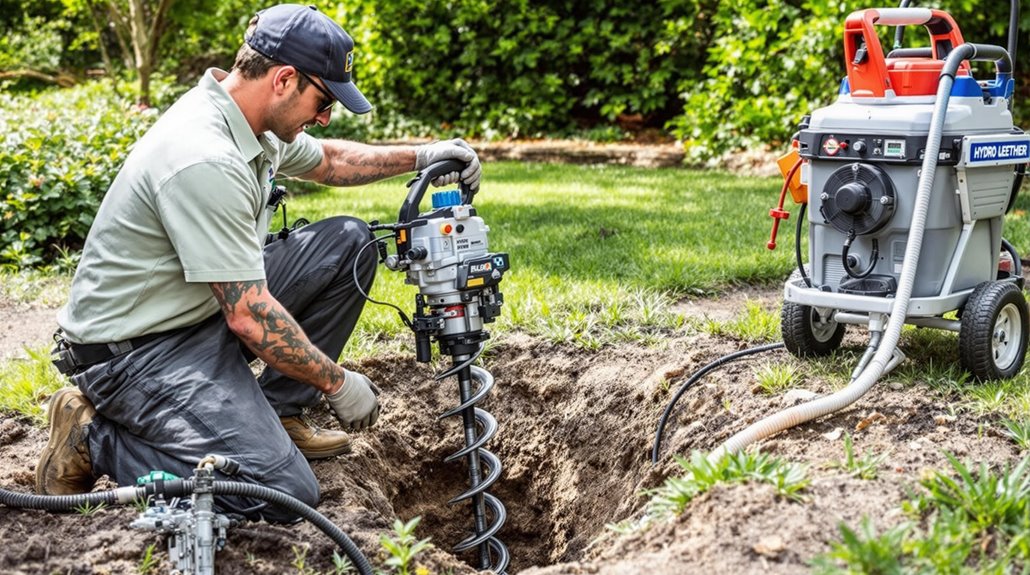
Severe drainage blockages and complex pipe issues often necessitate the expertise of professional cleaning services equipped with advanced technologies.
Professional cleaning options include specialized equipment like mechanical augers and hydro-jetting systems, which effectively clear stubborn obstructions that standard tools cannot address.
Licensed plumbers employ diagnostic methods such as snake cameras to inspect pipe interiors, identifying specific problems like root intrusion or structural damage.
This thorough assessment guarantees appropriate treatment selection and prevents potential pipe damage. Hydro-jetting, a powerful cleaning method utilizing high-pressure water streams, requires professional operation to maintain pipe integrity while removing accumulated debris and buildup.
While professional services typically cost between $100 and $500, this investment proves cost-effective for severe blockages, as it prevents further deterioration and costly repairs.
The expertise of Roto-rooting professionals, combined with their specialized equipment, delivers extensive solutions for maintaining underground drainage systems' ideal functionality and longevity.
Prevention and Regular Maintenance Tips
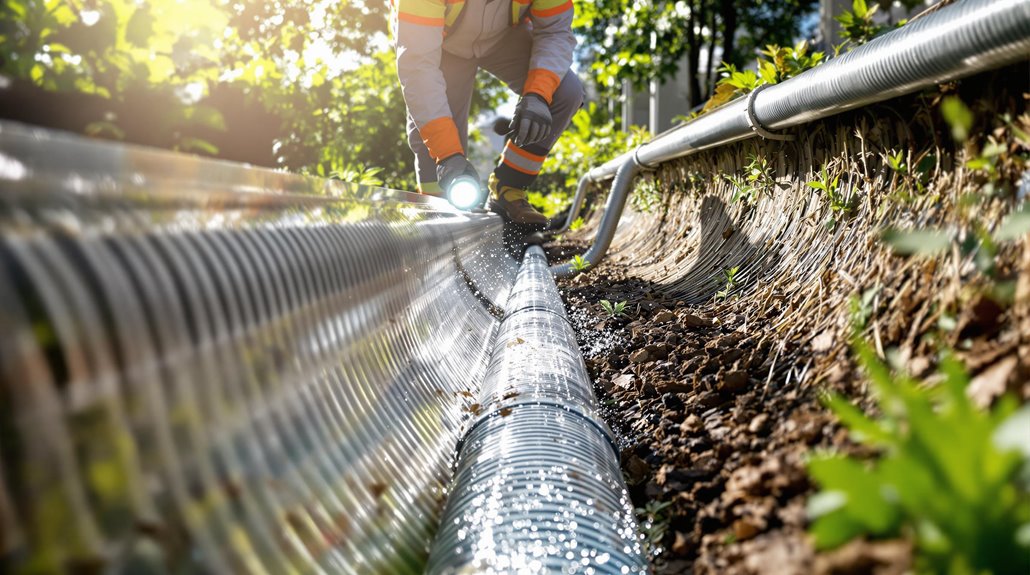
While professional interventions address major blockages, implementing systematic preventive measures can greatly reduce the frequency of drainage complications.
A thorough maintenance protocol requires bi-annual inspections of underground drainage pipes to identify potential issues before they escalate into significant problems.
Installing high-quality gutter guards, such as LeafFilter systems, serves as a primary defense mechanism against debris infiltration.
These protective barriers effectively minimize the entry of leaves, twigs, and other organic matter that could otherwise accumulate in the drainage system.
Additionally, seasonal maintenance of gutters and downspouts prevents large debris from being transported into underground pipes.
Strategic placement of filters at drainage openings provides an additional layer of protection by capturing smaller particulates while maintaining maximum water flow.
This multi-tiered approach to prevention, combined with scheduled professional cleaning services every few years, guarantees the sustained functionality of underground drainage infrastructure.
The Benefits Of Consulting A Public Adjuster

When dealing with extensive underground drainage damage that requires insurance claims, consulting a licensed public adjuster provides critical expertise in documentation and negotiation processes.
Public adjusters conduct thorough, objective assessments of drainage system damage while managing all aspects of the claim submission, which streamlines the often complex insurance procedures.
Statistical evidence indicates that policyholders who engage public adjusters typically receive considerably higher settlement amounts, with studies showing increases up to 800% compared to unrepresented claims.
Expertise In Insurance Claims
Insurance claim expertise plays an essential role in maximizing compensation for damaged underground drainage systems. Public adjusters possess specialized knowledge in policy interpretation and claim assessment, enabling them to identify coverage elements that property owners might miss when dealing with drainage infrastructure damage.
Their professional understanding typically results in 30-40% higher claim settlements compared to self-managed claims.
When drainage systems sustain damage, it's vital to contact a plumber for immediate assessment while simultaneously engaging a public adjuster.
These insurance professionals streamline the claims process by managing all insurance company communications and coordinating with their network of contractors and specialists.
Their technical expertise in documenting damage, calculating repair costs, and negotiating settlements guarantees policyholders receive appropriate compensation for underground drainage repairs while maintaining compliance with policy terms.
Objective Damage Assessment
Professional damage assessment through a qualified public adjuster provides three critical advantages for property owners facing underground drainage issues.
First, their expertise enables accurate identification and documentation of structural damage to subsurface drainage systems using industry-standard evaluation methods.
Second, public adjusters possess extensive knowledge of construction codes and local market costs, ensuring damage valuations reflect current repair or replacement expenses.
The third advantage lies in their ability to conduct an objective damage assessment that thoroughly examines all aspects of drainage system failure.
Their systematic approach includes evaluating hidden damage, documenting evidence according to insurance requirements, and providing detailed reports that support maximum claim recovery.
This methodical process helps property owners receive fair compensation while adhering to proper documentation protocols and industry compliance standards.
Streamlined Claim Process
Engaging a public adjuster markedly streamlines the underground drainage claim process while maximizing potential settlement outcomes.
Operating on a contingency fee basis, these professionals manage all documentation, negotiations, and insurer communications, enabling property owners to focus on drainage system restoration.
Public adjusters leverage their specialized certifications and thorough knowledge of local regulations to expedite claims related to underground drainage infrastructure.
Their expertise typically results in settlement increases of 30% or higher compared to self-managed claims.
Through systematic assessment and detailed documentation of drainage system damage, they guarantee compliance with insurance policy requirements while presenting compelling evidence for maximum compensation.
Their proficiency in industry-specific terminology and technical aspects of drainage systems enhances the presentation of claims, leading to more efficient resolution and ideal settlement outcomes.
Higher Claim Payouts & Settlements
Statistical evidence consistently demonstrates that enlisting a public adjuster's services yields substantially higher settlements for underground drainage claims.
Studies indicate that settlements involving public adjusters typically increase by 20-30% compared to policyholder-negotiated claims.
Public adjusters achieve higher claim payouts through their thorough understanding of insurance policies and expertise in damage assessment.
They meticulously document all aspects of drainage system damage, identifying coverage elements that policyholders might overlook.
Their specialized knowledge enables them to counter insurance company adjusters, whose primary objective is minimizing settlement amounts.
About The Public Claims Adjusters Network (PCAN)

The Public Claims Adjusters Network (PCAN) operates as a nationwide consortium of state-licensed insurance claim specialists who undergo rigorous vetting and verification processes. With coverage spanning more than 40 states, PCAN's member adjusters possess expertise in over 30 distinct claim categories, specializing in both residential and commercial property damage assessments.
PCAN maintains stringent quality control measures through mandatory annual audits of its members' licensing credentials and complaint records. The organization's thorough screening protocol includes intensive application reviews and professional interviews to guarantee only top-tier public adjusters gain membership. This systematic approach assures policyholders access to industry-leading expertise when maneuvering complex insurance claims.
The network serves as a critical intermediary, facilitating connections between property owners and qualified public adjusters while upholding the highest standards of professional ethics.
PCAN's infrastructure enables efficient deployment of specialized adjustment services across diverse geographical regions and claim types.
Frequently Asked Questions
How Do You Unclog Underground Drain Pipes?
Professional drain maintenance involves sequential steps: utilizing drain snakes for initial clearing, applying high-pressure water jetting, employing wet/dry vacuum extraction, and implementing hydro-jetting for severe underground blockages.
What Is the Best Way to Clean Out Underground Corrugated Pipes?
Professional clogged solutions for corrugated pipes include utilizing a corkscrew-tipped drain snake, followed by controlled water flushing, while monitoring with a snake camera for effective debris removal and pipe integrity.
How to Clean Out Underground Conduit?
Proper pipe maintenance requires disconnecting downspouts, utilizing drain snakes or augers for debris removal, applying high-pressure water jets, and employing wet/dry vacuum systems for stubborn blockages in underground conduits.
How to Clean Outdoor Drainage Pipes?
Professional drain maintenance involves disconnecting downspouts, utilizing drain snakes for debris removal, applying high-pressure water jetting, or employing wet/dry vacuums. Regular inspections prevent severe blockages in outdoor drainage systems.
